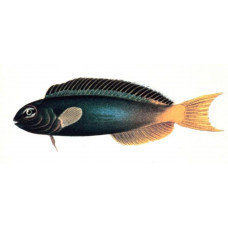Latin name
Meiacanthus atrodorsalis
Other name
Meiacanthus atrodorsaliseyelash harptail-blenny, poison-fang blenny, the yellowtail poison-fang blenny.
Identification
Adults have long filaments on the tips of the caudal fin.
Features of fish fins
Dorsal spines (total): 4; Dorsal soft rays (total): 25-28; Anal spines: 2; Anal soft rays: 15-18.
Fish colouring
Identified by a black diagonal line with a blue border running from the eye and a yellow dorsal fin or back.
Distribution
Western Pacific: from Bali and the Philippines east to Samoa, north to the Ryukyu Islands, south to the Rowley Shoals, southern Great Barrier Reef and New Caledonia; throughout Micronesia. Replaced by the uniform yellow species ovalauensis in Fiji and Meiacanthus tongaensis in Tonga.
Habitat
Marine tropical species. Depth from 0 to 30 meters. Inhabit coral reefs.
Size
This species reaches a length of 11 centimeters (4.3 inches).
Behavior
Adults are found singly or in pairs in lagoons and on inshore reefs below the surge zone in depths down to 30 meters.
Food and feeding habits
They feed on zooplankton and small bottom invertebrates.
Reproduction
Egg-laying. Eggs are ground-laying and adhesive. They are attached to the substrate with a fibrous adhesive pad. Larvae are planktonic, often inhabiting shallow coastal waters.
Fishing
Fished for sale to aquariums.
Relationship with a person
This poisonous species can be found in the aquarium trade.
| Classification | |
| Phylum | Chordata |
| Class | Actinopterygii |
| Squad | Blenniiformes |
| Family | Blenniidae |
| Genus | Meiacanthus |
| Species | M. atrodorsalis |
| Features | |
| Conservation status | Least Concern |
| Habitat | Bottom |
| Life span, years | No information |
| Maximum body weight, kg | No information |
| Maximum length, cm | 11 |
| Sailing speed, m/s | No information |
| Threat to people | Not edible |
| Way of eating | Predator |
Forktail blenny
Tags: forktail blenny

